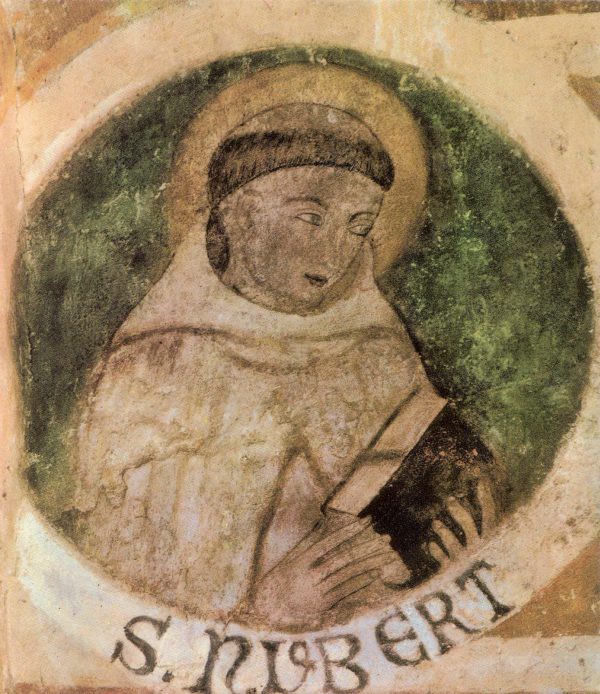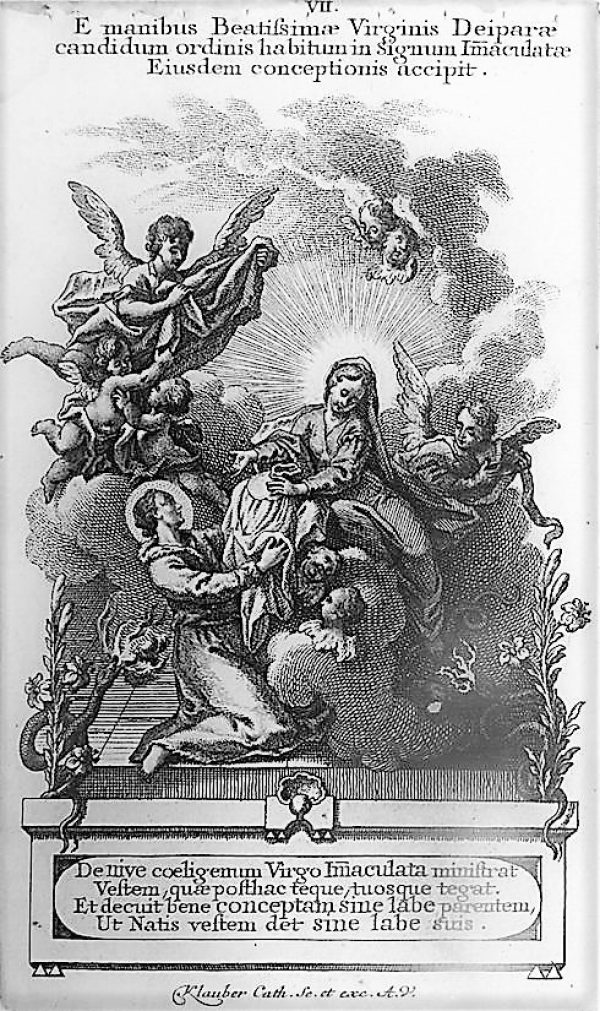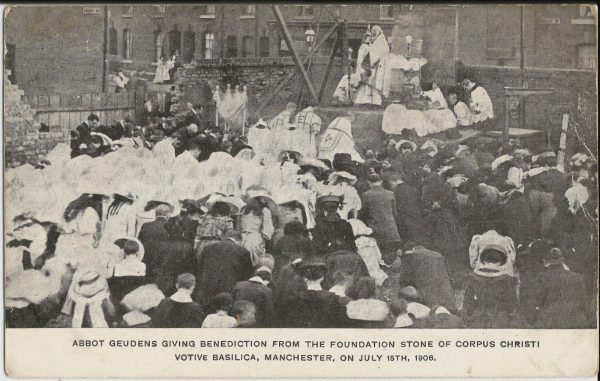History
Founded in 1120 by St. Norbert at Prémontré, near Laon, France. At first, members of his Order were not bound by any fixed rule, charity being the bond of their union, and the example of their founder their rule of life.
After a while, though, Norbert unfolded his mind to his disciples on the kind of rule they should adopt. He told them that he had already consulted learned bishops and holy abbots. Some had advised him to lead an eremitical life, others a monastic life, or else to join the Cistercians. He added that he preferred the canonical life of the Apostles, but that, before all, they must seek to know and do the will of God. It was then that St. Augustine appeared to him and gave him his Rule, saying, “I am Augustine, Bishop of Hippo; behold here the rule which I have written; if your fellow-brethren, my sons, shall have observed it well, they shall stand without fear in the presence of Christ on the terrible day of the last judgment.”
As all agreed to the choice of a canonical institute, Norbert composed a formulary of their profession, which they pronounced at Christmas, 1121. To this formulary the Saint added fasting, abstinence, and other works of mortification, together with some pious customs and practices peculiar to monastic orders, whereby his order became, as it were, ‘monastico-canonical.’ From its beginning the order also accepted parishes which were administered by Norbertine priests.
Spreading its branches
The Order of Prémontré increased very rapidly and, in the words of Adrian IV, spread “its branches from sea to sea.” Before the death of Bl. Hugh of Fosse, the first abbot general, 120 abbots were present at the general chapter. Of the first disciples, nearly all became abbots of new foundations, and several were raised to the episcopal dignity. Development was chiefly realised through the foundation of new abbeys, but several religious communities already in existence wished to adopt the constitutions of Prémontré and were affiliated to and incorporated with the order.
From the beginning, abbeys were founded in France, Belgium, and Germany, but colonies of the sons of St. Norbert were also sent to nearly every country of Europe and even to Asia. In 1130, King Stephen gave them his castle on the River Keres, and thus was founded the Abbey of St. Stephen, the first of numerous monasteries in Hungary. Almaric, who had shared in St. Norbert’s apostolate, a famous preacher in aid of the Crusades, was requested by Innocent II to preach in Palestine. At the head of a chosen band of Norbertines he set out in 1136 for the Holy Land, where he was hospitably received by Fulco of Anjou, King of Jerusalem, and by William, Patriarch of the Holy City. In the following year Almaric founded the Abbey of St. Abacuc. Henry Zdik. Bishop of Olmütz, made a pilgrimage to Jerusalem and visited St. Abacuc. He was so much touched by what he saw that he asked to be received into the order. Having obtained some religious, he returned to Bohemia and founded the Abbey of Mount Sion at Strahov, Prague. This abbey flourished so much that it was called the seminary of bishops, having given eight bishops to Prague, ten to Olmütz, and some to other dioceses; a patriarch (John of Luxemburg) to Aquileia, and a cardinal (John of Prague) to the Church.
In 1141, the Abbey of St. Samuel, near Jerusalem, was founded, and in 1145 another at Bethlehem. The abbeys were destroyed in 1187, when many of the religious were put to the sword or perished in the fire. Those who escaped founded a new community at Acre; but in 1291 this place, the last stronghold of the Christians in the Holy Land, was taken by the Sultan Saraf, who cut to pieces the abbot, Egide de Marle, and put the religious to death. In 1147, Abbot Walter of Laon led a colony to Portugal and founded the Abbey of St. Vincent, near Lisbon. Two young Spanish noblemen, Sanchez de Assures and Dominic, had heard of St. Norbert. They went to Prémontré and were admitted to the order by St. Norbert. Ordained priests, they were sent to preach in Spain, and having obtained a few religious from La Case-Dieu, an abbey in Gascony, they founded in 1143 the Abbey of Retorta, the first in Spain. In 1149, the mother-house sent some of its religious to found the Abbey of St. Samuel at Barletta, in Apulia, Italy.
At the same time sons of St. Norbert went forth from one abbey or another to found new houses in Great Britain and Ireland, Poland, Denmark, Norway, and even Riga on the Baltic Sea. In addition, 16 cathedral chapters were composed of Norbertine canons, under a bishop elected by them. One of these was Candida Casa, or Whithorn, in Scotland. It is impossible to give the exact number of abbeys, priories, and convents of nuns, so much do the various lists differ from one another. Perhaps the oldest list known is that which was made for the general chapter of 1320, and given by Le Paige. The most complete has been compiled by Hugo, the annalist of the order. Some authors say that there were 1300 abbeys and 500 convents of nuns, without counting the smaller residences, but these figures seem to be much exaggerated. However, whatever these lists may mean, they show the prodigious fecundity of the order during the first two centuries of its existence.
Decline and revival
Following the spending highs of the Order’s fortunes in the Middle Ages, wars, revolutions, religious upheavals and, in the East, the invasions of Tatars and Turks, made community life almost impossible and ruined many abbeys. The wars and the heresies of Hus and Luther destroyed several houses. The Abbey of Episcopia in the Isle of Cyprus was taken by Islam in 1571. The Hussites took possession of several houses in Moravia and Bohemia; the Lutherans, in Saxony, Prussia, Denmark, and Sweden; the Calvinists, in Holland; and Henry VIII in England and Ireland. In Hungary many were destroyed by Suliman. With all these losses the Order had 22 provinces or circaries in 1627, and Lienhardt gives a list of 240 houses still in existence in 1778.
Joseph II of Austria suppressed many houses and put others under commendatory abbots (in France, prior to the Revolution, Prémontré itself had been under several commendatory abbots, including Cardinal Richelieu). Leopold, Joseph's successor, restored nine abbeys, though, and with these he incorporated others. The French Revolution suppressed in 1790 all religious houses in France (including Prémontré), in 1796 in Belgium, and afterwards all those in the occupied provinces of the Rhine. Only a few houses were still in existence (nine in the Austrian Empire, three in Russian Poland, and 15 in Spain), but the abbeys in Spain were suppressed by the revolution which convulsed that country in 1833. The dispersed religious of the Belgian Province had long wished to reassemble and form new communities, but they were not allowed to do so under the Dutch Government (1815-30).
When Belgium was separated from Holland and made into an independent kingdom, freedom of religion was granted, and the surviving religious, now well advanced in years, revived community life and reconstituted five Norbertine houses in Belgium. The religious of the confiscated abbey of Berne in Holland founded a new abbey at Heeswijk. The Abbey of Berne-Heeswijk has founded St. Norbert's Priory at De Pere, Wisconsin, U.S.A. To the priory is attached a flourishing classical and commercial college. The Abbey of Grimbergen in Belgium obtained possession of the former Norbertine Abbey of Mondaye in France, and founded a new abbey. Mondaye in turn founded other houses. The Abbey of Averbode founded three Priories in Brazil with a college attached to each priory. The abbey of the Park, near Louvain, has also sent to Brazil several priests.
England
Only 22 years after the foundation of the Order in 1121, the White Canons came to England to establish the first Premonstratensian Abbey at Newhouse, in Lincolnshire. The founder was Peter of Goxhill. Between 1143 and the Dissolution of the Monasteries under Henry VIII, our order in England firmly established itself as part of the nation’s monastic and parochial life. Some 33 Abbeys and Priories are recorded during this period and then, as now, the main occupation of the Norbertine Canons was prayer and Apostolate in the parishes which depended on the Canons for their pastors.
Many other functions were fulfilled by our pre-Reformation confreres. In 1200, the Abbot of Torre (Devon) was appointed King John’s representative at the Papal Curia. In 1207, the Abbot of St. Radegmund (Kent) was sent as royal ambassador to Count William of Holland. Henry IV used the services of the Abbot of Alnwick (Northumberland) to negotiate with the Scottish Earl of March in 1400. The Abbot of Tichfield (Hampshire) had responsibilities for the building of Porchester Castle. England’s Treasurer in 1264 was a Norbertine Prior, while a certain Brother Thomas was a trusted advisor to Henry III.
A few early Norbertines attained distinction in intellectual and ecclesiastical fields. Many pre-Reformation abbots held law degrees from either Oxford or Cambridge. Abbot Makerell, took degrees at both Cambridge and Frieburg and was appointed suffragan bishop in the dioceses of York and Lincoln. Fr. Thomas Wygenhall, of the Abbey of West Dereham, wrote treatises on law and moral theology. “Richard the Premonstratensian” wrote a number of theological works; while Adam the Scot, born in the 12th century and known to have been a member of the community at Dryburgh, was renowned both as a preacher and a writer throughout Europe.
By far the most important work of the Order before the Reformation was to be found in the parishes. In the fourteenth century the Norbertines had some 150 parishes in England. The order’s contribution to the life of the Church in England, Wales and Scotland is witnessed to by the number of priests who were sent to work in diocesan parishes without, however, losing contact with the Abbey or Priory to which they belonged. These close links with the parochial apostolate would be characteristic of the order when it returned to England in 1872 after the centuries of Post-Reformation exile.
The return of the White Canons to England is the responsibility of two of the great abbeys of our order; the abbey of Tongerlo in Belgium and the abbey of Frigolet in France. At the request of local Catholics, the abbot of Tongerlo dispatched Fr. Martin Geudens to Crowle in Lincolnshire in 1872. This mission soon grew and attracted the first English vocations to the Norbertines since the Reformation. The Tongerlo canons established parishes at Spalding (1875), Stainforth (1931), Moorends (1937) and Holbeach (1956). During the Chapter of Reform more emphasis was put on community rather than parochial life and so these parishes are today administered by the secular clergy. In 1889, Norbertines first came to Manchester where they lived and worked at Corpus Christi in Miles Platting. It was there that our present canonry became an independent priory in 2004. Corpus Christi Basilica was closed in 2007 and the Canons moved to St. Chad’s Church in the Cheetham area of Manchester. The community transferred to Chelmsford in 2008.
The Canons of Frigolet first arrived on the shores of England on 1 February 1882 and were given a home in Storrington, Sussex through the benefaction of the Duke of Norfolk. In 1952, the priory of Storrington was transferred to the control of the Abbey of Tongerlo and became an independent priory of the order in 1962. These same exiled canons of Frigolet established houses and parishes at Farnborough (now a Benedictine abbey) in 1887, Weston 1888-92, Ambleside (now the diocesan church Mater Amabilis) in 1890 and Bedworth in 1892.
Today there are just over 1,000 members, of which approximately 800 are priests, brothers, deacons and novices, and approximately 200 are sisters. We are present in the following nations: France, Belgium, Netherlands, Britain (England), Ireland (Republic), Denmark, Germany, Spain, Italy, Austria, Hungary, Czech Republic, Slovak Republic, Poland, Romania, United States of America, Canada, South Africa, Democratic Republic of the Congo (formerly known as Zaire), Brazil, Chile, Peru, India and Australia.
With some revisions and the additional section on Britain, this abridged article is taken from F. M. Geudens O.Praem., “Premonstratensian Canons,” The Catholic Encyclopedia, Vol. 12. (New York: Robert Appleton Company, 1911). See Abbot Geudens’ full text.


